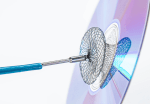The Treatment of severe aortic stenosis has experienced a significant revolution with TAVR, especially in high and intermediate risk patients, and it is now extending to low risk patients. In the US, nearly half of patients under 64 are being treated with TAVR. One of the fundamental questions that still remains unanswered revolves around device...
Left Atrial Appendage Closure and Concomitant Transcatheter Intervention: Can We?
Several scientific societies support performing left atrial appendage occlusion (LAAO) as a stand-alone procedure, even though it is often associated to other cardiomyopathies requiring transcatheter intervention. Though still controversial, combining LAAO and any other cardiac intervention might reduce hospitalizations, as well as the need for additional punctures, anesthesia, red tape, a longer stay and higher...
Does Post-Dilation in TAVR Affect its Long-Term Outcomes?
Transcatheter aortic valve replacement (TAVR) has widely demonstrated its significant benefits, both in high-risk and inoperable patients, as well as in those with intermediate and low risk. While paravalvular regurgitation has been a challenge, its management has improved with operator experience and a deeper understanding of CT angiographies. However, in cases of regurgitation, elevated gradient,...
Promising Results of Transcatheter Mitral Valve Replacement in Bioprosthesis Failure
Failure of a mitral bioprosthesis always poses a challenge regarding decision-making, especially when dealing with elderly patients with multiple risk factors. The scenario is worsened by the high risk associated with a new sternotomy and the significant impact of undergoing new surgery. Transcatheter mitral valve-in-valve (TMViV) replacement is emerging as a valid strategy in the...
Clopidogrel Monotherapy Beyond 12 months: Long Term Analysis of the STOPDAPT-2
Short dual antiplatelet therapy (DAPT) has shown benefits in patients receiving drug eluting stents (DES), reducing bleeding with no concomitant increase in major adverse cardiovascular events (MACE). Traditionally, the therapeutic window was limited to monotherapy with P2Y12 inhibitors during the first year and there are few data on short DAPT followed by long term monotherapy...
Transcatheter Mitral Valve Replacement: DOAC or VKA?
Severe mitral disease is common and currently constitutes a frequent cause of hospitalization and death. While surgery is the treatment of choice, transcatheter mitral valve replacement (TMVR) emerges as a valid alternative in cases of bioprosthesis failure, ring malfunction, or severe mitral annular calcification (MAC). Furthermore, the latest medical guidelines support the recommendation of TMVR...
TricValve: 12-Month Evolution
Tricuspid regurgitation has become increasingly common, and current pharmacological treatment options are limited. In turn, surgery, which is a complex alternative, carries considerable rates of complications and mortality. In response to this issue, various percutaneous systems are being developed, such as edge-to-edge treatment, percutaneous annuloplasty, and caval valve implantation (CAVI), among others. In the analysis...
Carotid Stenosis and TAVR
Aortic Stenosis affects over 5% of the population over 65. Even though TAVR has advanced in the treatment of this disease, many patients present carotid aortic stenosis (CAS), which involves additional surgical risk. This risk has not been thoroughly assessed in the context of TAVR. A meta-analysis was carried out including 5 observational studies with...
ACURATE Neo2: One-Year Hemodynamic and Clinical Benefit Results
Both Acurate Neo2 and its predecessor, Acurate Neo, have proven their safety and efficacy in the percutaneous treatment of severe aortic stenosis. The Acurate platform offers a lower gradient and a larger effective orifice area, as well as a low risk of periprocedural complications, according to previous registries. However, the first-generation Acurate device had some...
Evolution of Bicuspid Valves at 12 Months
Severe aortic stenosis due to a bicuspid aortic valve (BAV) is uncommon, especially in individuals under 65 years of age. While there are usually no significant differences according to the type of valve when it comes to surgery, with transcatheter aortic valve replacement (TAVR) some may arise. TAVR has seen significant advancements in the treatment...









